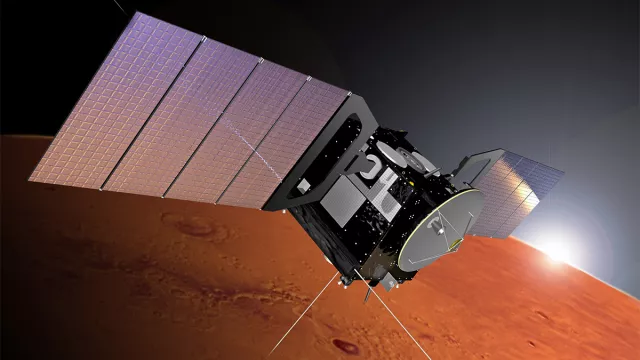The Mars Express satellite was launched by ESA in June 2003 to map the planet Mars, analyse its surface and subsurface, and study its atmosphere. ESA’s Science Programme Committee (SPC) has confirmed the mission’s extension to the end of 2026.
Key information
| Mission | Observation of Mars |
|---|---|
| Domain | Science |
| Launch date | 2 June 2003 |
| Partners | ESA, CNRS, IAS, LESIA, LATMOS, IRAP, IAPS (ex-IFSI, Italy), IKI (Russia), IASB (Belgium), IRF (Sweden) |
| Where | Near-polar (inclination 86°) elliptical orbit around Mars, at an altitude varying between 250 and 11,500 km |
| Lifetime | Initially scheduled to last two years, since extended |
| Status | In operation |
Key figures
- 2 m/pixel maximum spatial resolution
- 1,108 kg: mass of spacecraft and lander
- 7 instruments on spacecraft
- 5 contributing French laboratories
Key milestones
- March 2023: ESA extends mission for three years
- End 2018: ESA extends mission for four years
- 22 November 2016: ESA extends mission for two years
- 19 November 2014: ESA extends mission for two years
- November 2012: ESA extends mission for two years
- 2 October 2009: ESA extends mission for three years
- 3 March 2010: Mars Express flies within 67 km of Phobos
- 28 September 2005: ESA extends mission for two years
- 25 December 2003: Beagle 2 lander fails to land on Mars
- 25 December 2003: Mars Express goes into Mars orbit
- 2 June 2003: Mars Express launched by Soyuz
- Start 1997: ESA gives go-ahead to Mars Express mission
- End 1996: Mars 2001 project initiated
Project in brief
Launched on 2 June 2003, the Mars Express spacecraft entered orbit around Mars on 25 December of the same year and began its mission to map the red planet at a pixel resolution of 10 metres, sound its subsurface to search for pockets of water or ice, and finely analyse the composition of its atmosphere and ionosphere. Over the next 10 years, the European probe gathered a wealth of precious information, detecting the presence of clay and hydrated sulphates to confirm that liquid water once flowed on the surface of Mars, determining the nature and volume of water stored in its polar ice caps and undertaking a detailed analysis of the composition of the planet’s atmosphere and how it interacts with the solar wind. Mars Express also obtained unprecedented pictures of Mars’ small moon Phobos on three separate flybys in July 2008, March 2010 and January 2011.
The spacecraft was also carrying the Beagle 2 lander when it departed Earth. The small rover was released on 19 December 2003 but unfortunately contact was never established with it after that. Of the three instruments on Mars Express, two were built under French prime contractorship. OMEGA is a visible and infrared mineralogical mapping spectrometer conceived by the IAS space astrophysics institute in Orsay and the LESIA space and astrophysics instrumentation research laboratory in Meudon to study Mars’ surface mineralogy.
SPICAM (SPectroscopy for the Investigation of the Characteristics of the Atmosphere or Mars) is an ultraviolet and infrared atmospheric spectrometer dedicated to analysing Mars’ atmosphere and was developed by the LATMOS atmospheres, environments and space observations laboratory in Paris-Guyancourt. CNES has played a central role in developing and operating Mars Express, supplying technical support and funding for the development of OMEGA and SPICAM, and providing the ground segment for ASPERA (Analyser of Space Plasmas & EneRgetic Atoms), the third instrument on Mars Express to which France contributed. Developed under ESA’s Horizon 2000 science programme, the Mars Express mission has been extended to the end of 2026.
CNES’s role
CNES provided technical support and funding for the development of OMEGA and SPICAM, and built the ground segment for ASPERA.
Contacts
Project Leader, Solar System Planets and Small Bodies subject matter expert
Francis Rocard
E-mail: francis.rocard at cnes.fr


